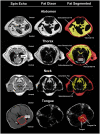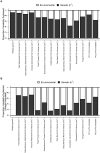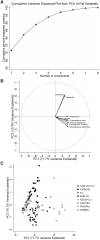Heritability of fat distributions in male mice from the founder strains of the Diversity Outbred mouse population
- PMID: 33720343
- PMCID: PMC8104956
- DOI: 10.1093/g3journal/jkab079
Heritability of fat distributions in male mice from the founder strains of the Diversity Outbred mouse population
Abstract
Specific fat distributions are risk factors for complex diseases, including coronary heart disease and obstructive sleep apnea. To demonstrate the utility of high-diversity mouse models for elucidating genetic associations, we describe the phenotyping and heritability of fat distributions within the five classical inbred and three wild-derived founder mouse strains of the Collaborative Cross and Diversity Outbred mice. Measurements of subcutaneous and internal fat volumes in the abdomen, thorax and neck, and fat volumes in the tongue and pericardium were obtained using magnetic resonance imaging in male mice from the A/J (n = 12), C57BL/6J (n = 17), 129S1/SvlmJ (n = 12), NOD/LtJ (n = 14), NZO/HILtJ (n = 12), CAST/EiJ (n = 14), PWK/PhJ (n = 12), and WSB/EiJ (n = 15) strains. Phenotypes were compared across strains using analysis of variance and heritability estimated as the proportion of phenotypic variability attributable to strain. Heritability ranged from 44 to 91% across traits, including >70% heritability of tongue fat. A majority of heritability estimates remained significant controlling for body weight, suggesting genetic influences independent of general obesity. Principal components analysis supports genetic influences on overall obesity and specific to increased pericardial and intra-neck fat. Thus, among the founder strains of the Collaborative Cross and Diversity Outbred mice, we observed significant heritability of subcutaneous and internal fat volumes in the neck, thorax and abdomen, pericardial fat volume and tongue fat volume, consistent with genetic architecture playing an important role in explaining trait variability. Findings pave the way for studies utilizing high-diversity mouse models to identify genes affecting fat distributions and, in turn, influencing risk for associated complex disorders.
Keywords: Collaborative Cross; Diversity Outbred; fat distributions; founder strains; heritability; magnetic resonance imaging; mice.
© The Author(s) 2021. Published by Oxford University Press on behalf of Genetics Society of America.
Figures





References
-
- Bao M, Yang Y, Jun HS, Yoon JW.. 2002. Molecular mechanisms for gender differences in susceptibility to T cell-mediated autoimmune diabetes in nonobese diabetic mice. J Immunol. 168:5369–5375. - PubMed
-
- Bixler EO, Vgontzas AN, Lin HM, Calhoun SL, Vela-Bueno A, et al.2005. Excessive daytime sleepiness in a general population sample: the role of sleep apnea, age, obesity, diabetes, and depression. J Clin Endocrinol Metab. 90:4510–4515. - PubMed
Publication types
MeSH terms
Associated data
Grants and funding
LinkOut - more resources
Full Text Sources
Other Literature Sources
Molecular Biology Databases
Miscellaneous
